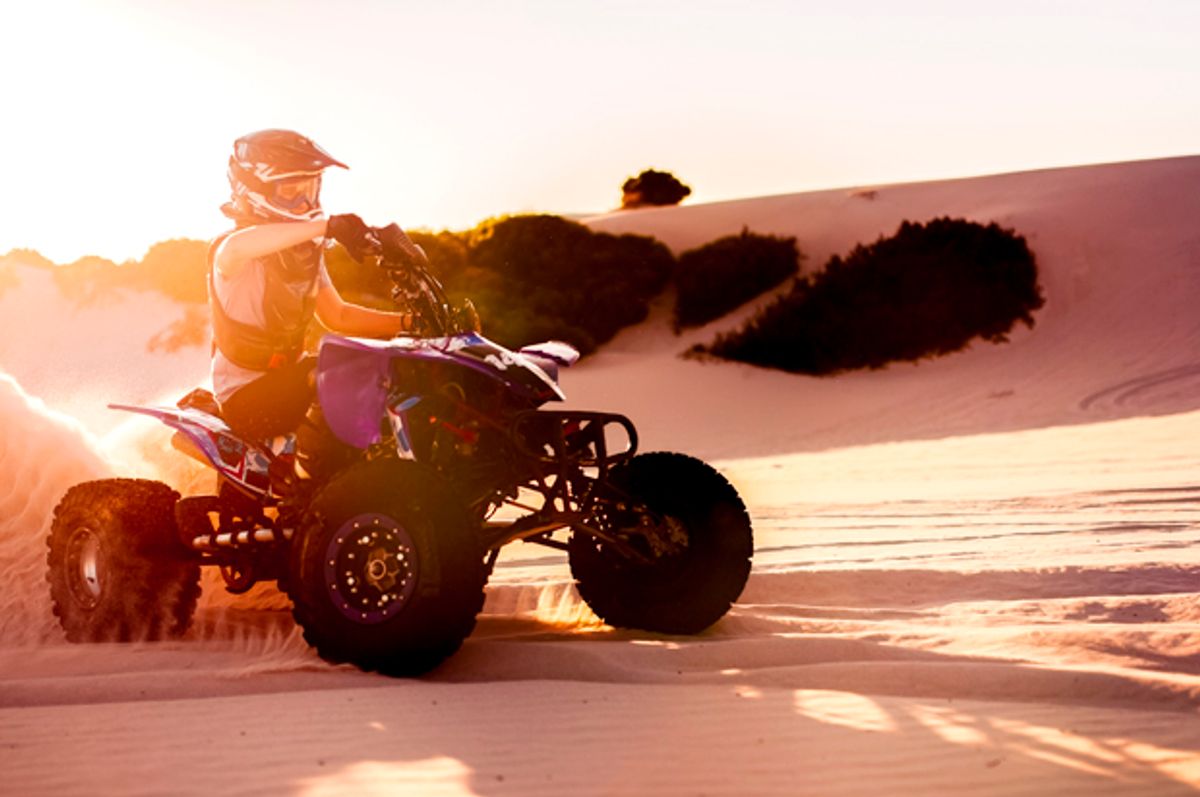 More than 14,000 people, including roughly 3,200 children age 15 or younger, have been killed in crashes of all-terrain vehicles since federal safety officials began keeping track in the early 1980s.
More than 14,000 people, including roughly 3,200 children age 15 or younger, have been killed in crashes of all-terrain vehicles since federal safety officials began keeping track in the early 1980s.
Studies have shown (here and here) that over half of the deaths occur on public or private roads — even though ATVs are required to display safety warnings that they are not designed to be operated safely on roads.
Yet in recent years, officials in small towns and rural areas around the country, at the urging of riding enthusiasts, have been approving the use of ATVs — and other off-road machines known as recreational off-highway vehicles, or ROVs — on public roadways. Safety advocates have pushed back, but they are losing more fights than they win.
“This is an uphill battle,” acknowledged Rachel Weintraub, general counsel of the Consumer Federation of America, which has spearheaded efforts to restrict use of off-highway vehicles on paved, dirt and gravel roads.
Off-highway vehicles can reach highway speeds but, with their low-pressure tires and high center of gravity, they are prone to tip over or go out of control on roads.
As FairWarning has reported, while the Consumer Product Safety Commission regulates hazardous products and the National Highway Traffic Safety Administration oversees traffic safety, neither federal agency has authority over where people operate off-highway vehicles, leaving the issue in state and local hands. At the same time, the safety commission has warned that children under 16 should not drive adult-size ATVs and that the vehicles should not be operated on paved roads.
Undercutting the industry’s official position
Safety advocates have unsuccessfully urged the commission to expand its warning, a position that was bolstered by a 2016 University of Iowa study finding that 42 percent of ATV roadway deaths occur on unpaved surfaces. “ATVs are designed for off-road use only and multiple factors make them at risk for loss of control on both paved and unpaved roads,” study co-author Charles A. Jennissen wrote in a letter to the commission.
The Specialty Vehicle Institute of America, a manufacturers trade group, takes the position that “ATVs are designed, manufactured and sold for off-road use only.” But a FairWarning review found that leading manufacturers and dealers sometimes have supported groups or made statements that undercut the industry’s official position.
Yamaha, for example, states in its ATV owner’s manuals: “Never operate an ATV on any public street, road or highway, even a dirt or gravel one.” But Yamaha, through a grant program that provided more than $350,000 last year for trail development, maintenance and safety, gave a portion to riders clubs that also fight for opening public roads to off-highway vehicles.
For example, a Yamaha grant of $10,000 went to the Alvwood Squaw Lake ATV Club in Minnesota. Two years earlier, the club persuaded the Itasca County Board to open county roads for ATV use to connect trails.
Yamaha did not respond to requests for comment.
Polaris, which bills itself as the world leader in an industry that annually sells about 400,000 ATVs and 480,000 ROVs, has also provided trail grants to a handful of rider clubs that have pushed for local governments to open public roadways.
At least one of the firm’s dealers, Premier Polaris in Monroe, Wash., uses its website to lobby for increased street access.
Polaris, based in Medina, Minn., declined an interview request but, in a prepared statement, said, “Our vehicles are designed for off-road use and should not be operated on public roads, unless they have been marked for off-road use by local or state legislation.”
The Consumer Federation of America’s Weintraub said Polaris’ reference to local or state legislation “entirely muddies the water.”
In the first half of 2017, the federation sent 28 letters highlighting the hazards to government bodies considering on-road use. That’s nearly as many as in all of 2015 or all of 2016, a response to the stepped up push at the local level by off-highway enthusiasts.
But this year, at least eight governments — including cities and counties in Minnesota, Indiana, Michigan and Wisconsin and the state legislature of Utah — have approved the opening of roads.
The federation knows of only two communities — Wellsville, N.Y., and Fripp Island, S.C. — that decided against opening roadways this year after getting the warning letters.
Injuries more serious on roadways
The Specialty Vehicle Institute of America trade group says it also sent letters in the last couple of years opposing more than 60 measures in 23 states.
But pushed by riders and local business interests, more than two-thirds of the states now allow off-highway vehicles on some public roads, or permit local jurisdictions to allow them.
Nearly 100,000 people are hurt annually in ATV crashes, according to federal figures. Researchers have found that roadway injuries tend to be more serious than those on forest trails and other off-road locations. A study published in July by the journal Pediatrics found a more than 10 percent decline in children’s ATV injuries in Pennsylvania in recent years. But the researchers noted that the use of ATVs on paved roads, “especially among adolescents, increases the mortality rate.”
Researchers tend to focus only on ATV injuries because comprehensive statistics are not available for ROVs. However, as FairWarning reported in 2015, hundreds of people have been killed in ROV crashes. Sales of these vehicles have skyrocketed since their introduction in the early 2000s as an alternative to ATVs. Unlike ATVs, which the rider straddles like a motorcycle, ROVs are more Jeep-like in appearance, have bench seating for two or four riders and include safety features such as seat belts.



Shares